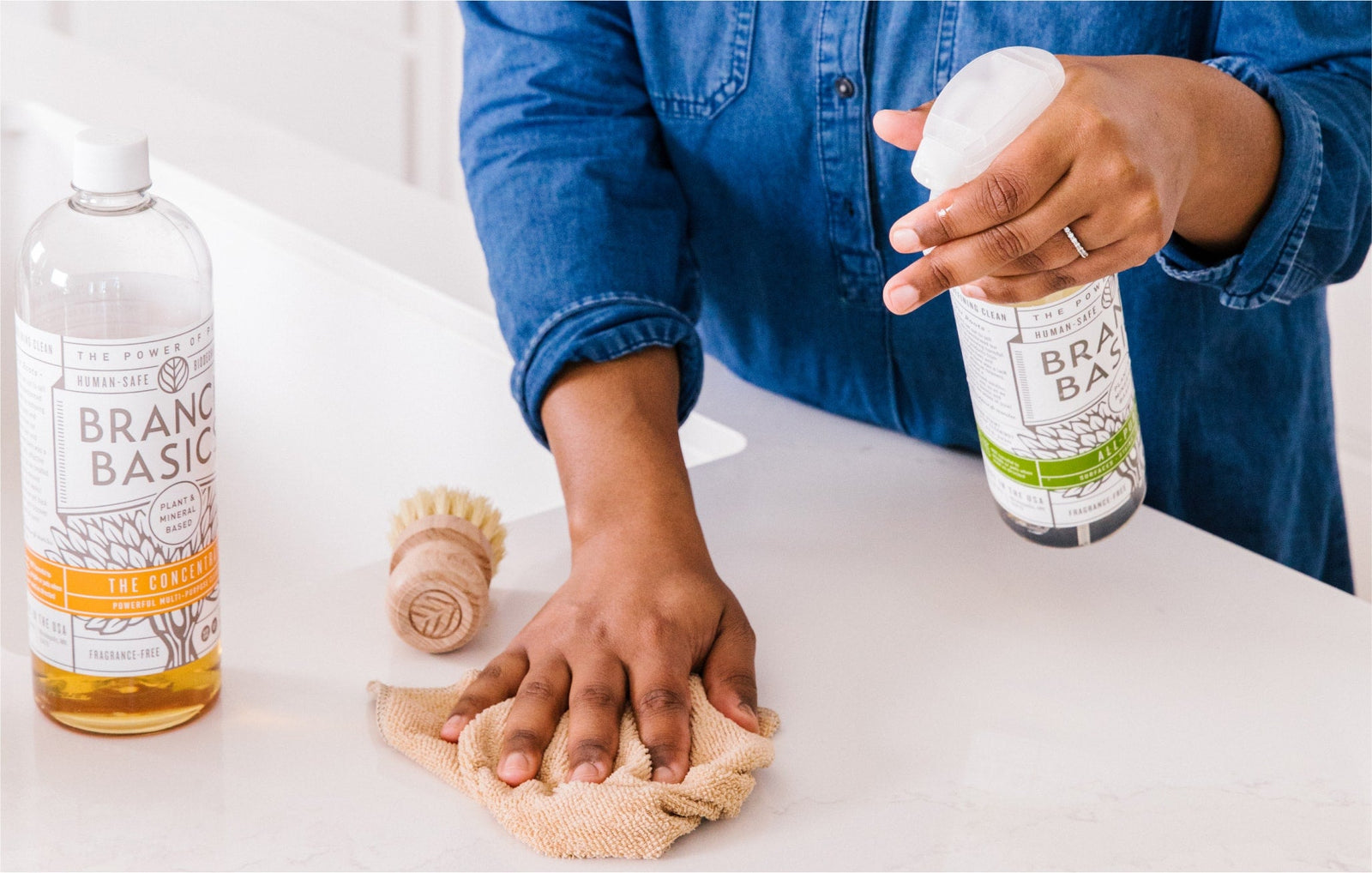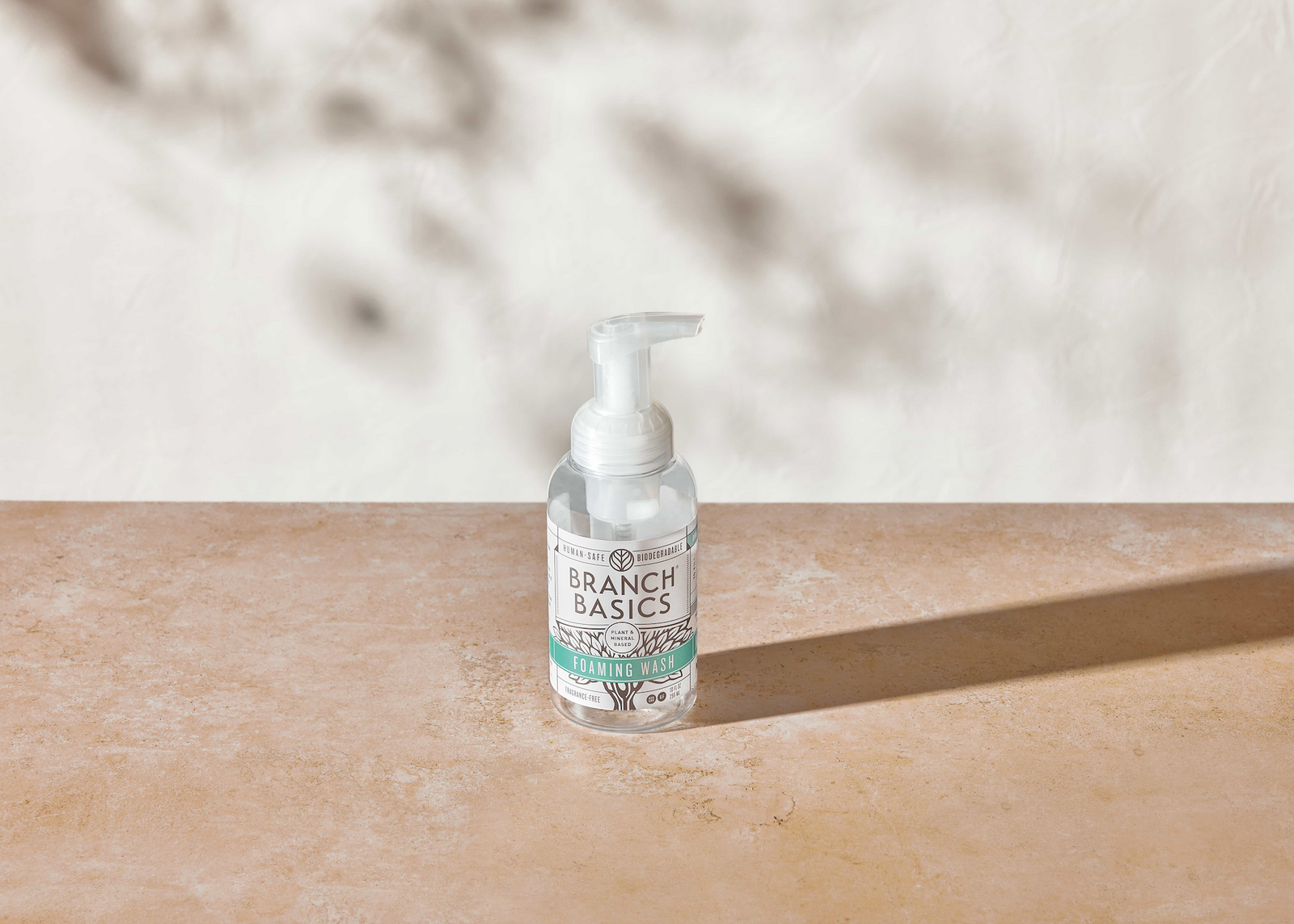Is Branch Basics a Sanitizer or Disinfectant?

The answer is neither.
Branch Basics is not a sanitizer nor a disinfectant, and that’s on purpose. But before we explain how Branch Basics removes germs, it is important to understand why scientists debate the use of sanitizers and disinfectants (and why we prefer soap and water instead).
3 Things to Know About Sanitizers & Disinfectants

The use of sanitizers and disinfectants is a current hot topic for the following reasons:
1. Sanitizers and disinfectants contribute to antimicrobial resistance
To be classified as a sanitizer or disinfectant the product must contain an EPA registered pesticide or a high percentage of alcohol – at least 62%. The use of sanitizers with EPA registered pesticides have been shown to contribute to the increasing problem of antibacterial resistance.
Check out these sources to learn more about antibiotic resistance:
- ABC News – Antibacterial Soaps Concern Experts
- BBC - Antibiotic resistance as Big a Risk as Terrorism
- Nightmare Bacteria Growing Threat - Antibiotic Resistance
The disturbing discovery in hospitals that alcohol based sanitizers are creating superbugs was unexpected. Sanitizers using alcohol such as ethyl alcohol (the same alcohol that is in wine, beer and liquor) were thought to not cause a superbug issue because alcohol acts in a completely different manner than a pesticide.
Alcohol kills germs within seconds through a mechanical action by physically destroying the cell membrane. Scientists thought that there was no mechanism by which the germs could become resistant to it, but unfortunately, it turns out that some bacteria are quite adaptive and have developed resistance to sanitizers with alcohol.
Learn more about alcohol resistance:
2. They may weaken your immune system
The discovery that the use of antibacterial products may be weakening our immune systems. Some exposure to germs is good since that allows our immune systems to build up its own resistance.
Read about the effects of sanitizers and disinfectants on the immune system:
- Antibacterial Soaps Can Hurt Children’s Immune Systems
- Too Much Hygiene May Affect Immune System
- Dangers of Waterless Hand Soap/Hand Sanitizers from Livestrong
- Children/Hygiene and The Development of Allergies
3. Pesticides found in hand sanitizers and disinfectants may be endocrine disruptors
The EPA registered pesticides penetrate the skin and enter the body and can cause hormonal disruption, which can lead to a variety of negative health effects.
Check out these articles for more information on the effects of endocrine disruptors on your body:
- Scientists Urge UN to take action on Hormone Disruptors in Consumer products and Pesticides
- Beyond Pesticides
The pesticides in personal care products like hand sanitizers and disinfectants are infiltrating our water supply, which also can impact or disrupt hormones.
How to Remove Germs the Safe Way

By Washing Hands
Washing hands with a pure soap and water or a cleaner like the Branch Basics Concentrate is the best way to remove germs. Proper hand washing instructions for using a product like Branch Basics to wash away germs according to the CDC are:
- Using a foamer or spray bottle apply Branch Basics liberally to the hands.
- Lather your hands by rubbing them together with the soap. Be sure to lather the backs of the hands, between the fingers, and under your nails.
- Rub hands together or scrub for at least 20 seconds. Hum the “Happy Birthday” song from beginning to end twice.
- Rinse with clean, running water.
- Dry hands using a clean towel or air dry them.
Related Reading: Is Branch Basics Worth It?
Cleaning the Bathroom
Using Branch Basics in the bathroom removes germs. For best results spray the surface with Branch Basics Bathroom cleaner, let sit a couple of minutes then scrub the toilet with a brush and flush.
For cleaning floors and other surfaces, spray Bathroom cleaner and let sit a couple of minutes and wipe with a microfiber or microfiber mop. Microfibers are best because bacteria has an overall negative charge and the positively charged microfiber grabs hold onto the germs and particles and removes them from the surface.
Related Reading: How to Clean Your Bathroom Naturally With Branch Basics
Cleaning Cutting Boards
Such as, where raw meat, chicken, or fish has been.
The CDC has done testing that shows conclusively that cleaning with a natural soap or a surfactant based cleaner removes all germs whereas cleaning the same area with a sanitizer or disinfectant leaves resistant germs on the surface. In addition, most of these products have a dwell time and for the most part, consumers aren’t even aware of this factor.
In other words, if you have a sanitizer that contains an EPA registered pesticide and you just spray it and wipe it, you are not killing germs. It has to sit there for a period of time to do its work – dwell time is typically 30 seconds to 10 minutes.
Germs are forever increasing and mutating, making them harder to eliminate and protect against. So the bottom line is sanitizers and disinfectants add harmful chemicals to the air and surfaces and encourage the spread of resistant superbugs in your home.
Simple steps:
1. Scrape/rise off all leftover food
2. Spray Branch Basics directly onto the surface
3. Allow 2-5 minutes “dwell time"
4. Wipe surface clean with a microfiber and rise with hot water
Related Reading: How to Clean & Disinfect Cutting Boards
Cleaning with Vinegar and Hydrogen Peroxide
Study shows that Vinegar and 3% Hydrogen Peroxide used in combination (in separate bottles) are more effective at killing germs than chlorine bleach or any commercially available kitchen cleaner. Vinegar is good at killing some germs and hydrogen peroxide is better at killing others.
Team Branch Basics and Microfiber with Vinegar and Hydrogen Peroxide for a Powerful Homemade Disinfectant Team
Materials Needed:
- Branch Basics All-Purpose or Bathroom Cleaner
- Split fiber Microfiber
- Distilled White Vinegar (5% acidity)
- Hydrogen Peroxide (3% solution - brown bottle)
- A spray nozzle for the brown bottle of peroxide
- A spray bottle for the vinegar (or a spray nozzle for the bottle if it will fit)
Related Reading: Using Your Own Bottles for Branch Basics Concentrate, How to use Hydrogen Peroxide as a Safer Alternative for Cleaning, Disinfecting, Laundry and More
Cleaning and Disinfecting Process:
- Clean the surface or object to remove germs with Branch Basics or another human-safe cleaner.
- Spray a few sprays of vinegar or peroxide on the surface, and let the one product dwell for 5-10 minutes. Do not use them simultaneously, as this could create harmful fumes.
- Wipe thoroughly.
- Then spray the other product on the same surface. Let dwell and wipe thoroughly.
Helpful tip: affix a spray nozzle directly to the bottles for ease of use.
Again, these are only to be used separately (spray one first, wipe, then spray the other) and stored in separate bottles.
We love using this combination on cutting boards, countertops, high chairs, pacifiers, toilets, toys, or any surface or item that may harbor harmful germs.
Using A Steam Cleaner
Dry vapor steam cleaners use superheated low moisture steam for disinfecting, sanitizing, and cleaning surfaces. It is an amazing way to mechanically disinfect naturally without creating fumes or waste.
We recommend the Ladybug Dry Steam Cleaner, which is unique for the following reasons:
- The Ladybug qualifies as a disinfection device* for the EPA. It disinfects virtually any hard surface (through proprietary TANCS® technology) thousands of times better than the standard that chemical disinfectants must meet to qualify as an EPA-registered disinfectant.
- Unlike chemical disinfectants that require dwell times where surfaces must remain visibly wet for minutes to kill germs, the Ladybug kills an extensive range of bacteria and viruses like MRSA, C. diff, norovirus, C. parvo, and COVID-19 in seven seconds or less while leaving no residue behind that promotes new microbial growth.
- It is also proven to eradicate hard-to-kill biofilms in three seconds. Strong chemical disinfectants such as bleach are no match!
So, how is mechanical disinfection different from chemical disinfecting?
Mechanical disinfection with the Ladybug does not create superbugs, because there is no chance for a germ to mutate to the point that it can resist the natural heat. Once again, nature provides a win-win solution.
The Ladybug Dry Steam Cleaner works well with Branch Basics or other human-safe cleaners.
Pure and Natural Cleaning is Easy With Branch Basics
Want a clean home without the synthetic-chemicals? No problem. Try the Branch Basics Starter Kit to #TossTheToxins while still creating a clean, healthy space.
MORE INFO ON HANDWASHING:
- CDC Recommendations on Handwashing and Hand Sanitizer Use
- Mayo Clinic: Hand-washing: Do's and don'ts
- FDA: Antibacterial Soap? You Can Skip It, Use Plain Soap and Water
FAQ: I still want to get rid of germs, how do I do it?
So, it is important to realize that using a sanitizer or disinfectant does not take care of all germs. This has been shown in study after study because the germs have developed resistance and are not killed.
In fact, using just plain soap and water or a cleaning soap product with surfactants like Branch Basics is much more effective than sanitizers/disinfectants at removing ALL GERMS. In addition, “to date, studies have shown that there is no added health benefit for consumers using soaps containing antibacterial ingredients compared with using plain soap.*” (from the CDC website)
Related Reading: 3 Tools You Need to Become Your Own Product Advocate

Marilee Nelson
Marilee Nelson is an Environmental Toxins expert who has spent nearly 30 years advocating for the chemically-sensitive and chronically-ill. She is a Board Certified Nutritionist, Certified Bau-Biologist and Bau-Biology Inspector and specializes in Food As Medicine. She has helped thousands of families and individuals identify, heal and recover from toxic exposures and is on a mission to revolutionize the way American families view their health.








